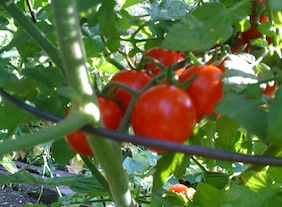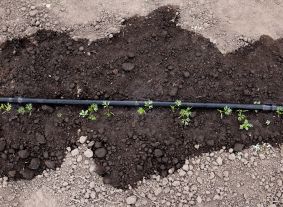Tomatoes: Seeds or Plants? The Answer is Both.
Views: 3231

It’s almost Memorial Day, and most vegetable gardens are either completely planted or nearly so, tomatoes included.
I usually try to finish up my planting between the 15th and the end of the holiday weekend. The soil is reliably warm and even the night temperatures are somewhat warm.
This weekend was a major planting weekend in my community garden. Lots of warm-weather vegetables went in—peppers, zucchini and squashes, melons, and tomatoes. Especially tomatoes. I’ve previously talked about the importance of planting these summer heat lovers once the ground and air temps stabilize above 50F. And just this weekend I was shown evidence of why.
A fellow gardener fairly new to the hobby asked why the tips of his tomato plants were brown and curling. He’d planted his maybe 1-foot-tall tomato transplants about two weeks ago. The days since then were mostly rainy and chilly, with several nights dipping down into the high 40s. Sure, you can have days on end of warm weather, I told him, but one night can set your plants back more than you think. For me, it’s not worth the risk.
Growing from seed
This year, I’m trying something new, something inspired by my parents. My parents can be… frugal. Let’s call them frugal. Last summer, instead of buying all of their tomato plants as transplants from the garden center, they planted half of their tomato crop as transplants, and planted the other half of their crop as direct-sown seed.
They purchased several (10 or 12) tomato plants that were planted in mid to late May and nicely caged and pruned them throughout the summer. The other portion of their tomato plot was a row or two of tomato seeds—the Black Krim and Purple Cherokee hybrid varieties—that they sowed in the first week in May.
The tomato seedlings really started to take off as the weather heated up. They thinned their rows of seedlings, but not extravagantly so. My parents had no intention of staking or training or pruning. They just sort of let that row of tomatoes spill into each other as they grew.
Perfect late-season tomatoes
The older plants started ripening near mid to later July, but the younger set didn’t really start flowering until mid August, with fruit ripening later in September. As the older plants started to look tired and exhausted, the younger plants were just pumping out their crop, and they kept growing and producing until frost really closed the curtain on them. The older plants had exited stage left weeks earlier.
In effect, Mom and Dad had two crops of tomatoes: A typical crop that they ate fresh, and a later crop that pumped out larger quantities of tomatoes that they then canned, with the very end of that harvest being eaten fresh and as late as possible. It was a stroke of genius on their part, and hopefully the same strategy will work for me this year.
Meet Ellen Wells
When you’re raised on a farm, you can’t help but know a thing or two about gardening. Ellen Wells is our expert on edible gardening.…
Ellen's Recent Posts

Asparagus






